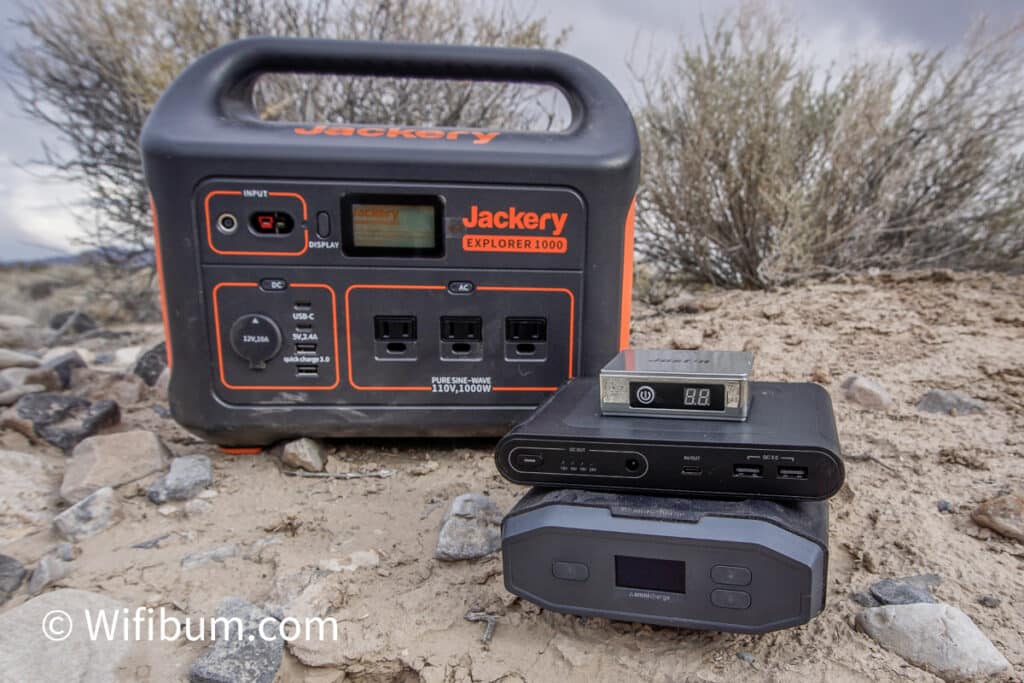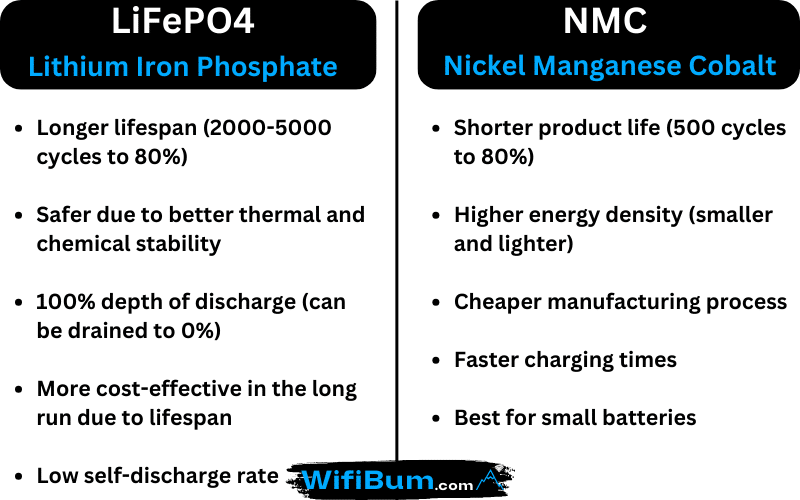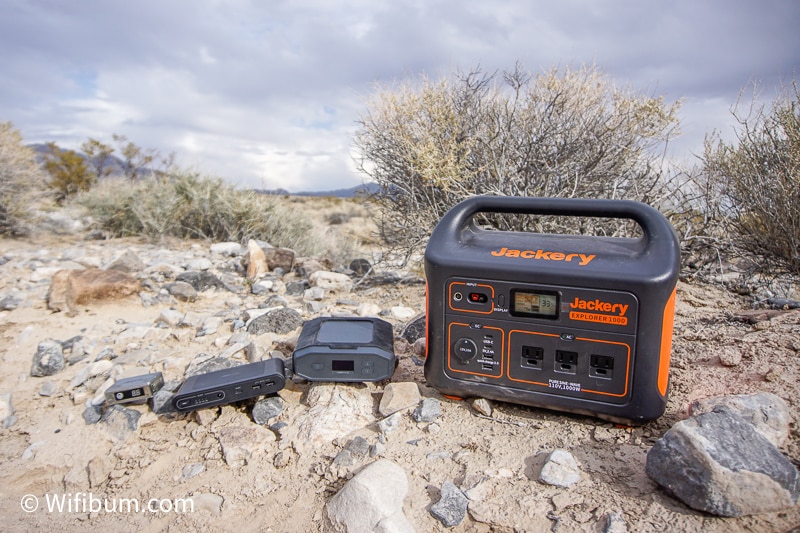The battery type of a portable power station is critically important.
It’s not just about power. The battery dictates the power station’s cost, weight, and lifespan.
It will influence how often you’ll need to replace or maintain the unit, its safety parameters, and even its performance in various conditions.
The most common batteries used in portable power stations are LiFePO4 (LFP, Lithium Iron Phosphate) and NMC (Nickel Manganese Cobalt).
In this guide, we’ll delve into the nuances of these two technologies to help you make an informed decision.

My website uses affiliate links where I may earn a small amount at no cost to you. Thanks!
What is the Difference Between Lithium NMC and LFP Batteries?
There are several key differences between LiFePo4 (LFP) and NMC batteries. Here’s an infographic showing the key points, then I’ll dive into the details.

LiFePO4 (LFP) Batteries
Let’s start with an overview of the benefits of LFP power station batteries.

Primary Benefits of LFP Batteries
The primary characteristics of LiFePO4 (LFP) batteries are:
- Long lifespan (cycle life) – In my opinion, this is the most important feature and makes LFP more economical. Most companies state 3000 to 4000 cycles before the battery is at 80% of its original capacity (compared to 500 for NMC).
- Safety – stable chemical composition means it’s less likely to overheat or catch fire. This is another consideration when keeping a power station in a hot vehicle while camping or using a power station for van life.
In addition, they tend to perform better in extreme conditions, especially when it’s hot. And they are more eco-friendly than NMC as they contain fewer environmentally harmful chemicals.
Disadvantages of LFP Batteries
The disadvantages of LiFePO4 (LFP) batteries are:
- Heavier – bulkier and heavier for the same capacity vs NMC
- Lower Max Output – They tend to perform worse when powering high-powered devices continuously
NMC (Nickel Manganese Cobalt) Batteries
NMC batteries were very popular when power stations first started taking several years ago.
Jackery power stations became extremely popular and exclusively used NMC battery chemistry up until mid-2023 and now they offer both.

Primary Benefits of NMC Batteries
- Energy Density (ie: lightweight) – NMC’s claim to fame is delivering more power for their size and weight.
- Compact Design – Higher energy density means more compact designs, making NMC a great option for portability.
- Higher Max Output – Ideal for those high-demand devices or appliances (think running a power tool for long periods of time). This is why they are used in electric vehicles.
NMC batteries are a great option when weight and size are important. However, there are a several drawbacks.
Disadvantages of Li-NMC Batteries
The disadvantages of NMC batteries are:
- Short Lifespan – rated for about 500 discharge cycles until it is 80% capacity
- Temperature Performance – can underperform in extreme heat or extreme cold
- More volatile if mishandled – While generally safe, the chemistry is not as stable as LFP
Comparison of LiFePO4 vs NMC Batteries
Understanding the differences between LiFePO4 (LFP) and NMC batteries is essential for making informed decisions for specific applications. Each parameter below highlights a distinct characteristic of these batteries and why you should consider it when purchasing a power station or solar generator.

In 2019 when I made my first major power station purchase, there wasn’t much discussion on this topic and I wish there had been.
Energy Density

Energy density determines how much energy a battery can store in a given volume. A higher energy density means more power in a smaller package, essential for space-constrained applications.
Energy Density = Battery Watt Hours / Weight
LFP Battery
While LFP batteries are robust, their energy density is generally lower than NMC, resulting in a larger size for the same capacity.
NMC Battery
NMC batteries typically have a higher energy density, making them compact and suitable for devices needing minimal bulk.
For example, Ecoflow, a popular power station brand, sells both LiFePO4 and NMC in the same size (click to see my EcoFlow LiFePO4 power stations article).
An NMC battery is ~150-200Wh/Kg and LiFePO4 is 100-150 Wh/Kg.
However, new designs and innovations are making them more comparable.
The EcoFlow Delta is NMC and the Delta 2 is LiFePO4, both with 1008Wh and 1024Wh capacity, respectively. The Delta NMC is 14kg while the Delta 2 LiFePO4 is 12kg which proves that design and parts can impact this general rule of thumb. (Source: EcoFlow).
Winner: NMC
Cycle Life and Lifespan of Battery

The cycle life indicates how many times a battery can be charged and discharged before its capacity significantly diminishes. A higher cycle life means longer battery lifespan, reducing replacements.
LFP Battery
LFP batteries shine here, boasting a longer cycle life which can translate to extended usability and reduced long-term costs. Most manufacturers suggest 3000 to 5000 cycles.
NMC Battery
NMC batteries generally have a decent cycle life, but it’s often shorter than LFP batteries. This may mean more frequent replacements over time. Most manufacturers suggest 500 to 1000 cycles.
These facts express themselves in the warranties of each battery type. Most LFP units will have a 5-year warranty while NMC will have 1 to 3-year warranties.
Winner: LFP
Depth of Discharge

Depth of Discharge (DoD) reflects the percentage of the battery that can be discharged safely without harming its lifespan. A higher DoD means more usable capacity.
LFP Battery
LFP batteries can typically be discharged 100% without harming the battery. This is a huge benefit as you don’t have to worry about monitoring your battery levels.
It’s rare that I ever caught my battery before it went below 20%, so having an LFP is simply more practical.
NMC Battery
NMC batteries often have a good DoD but might not match the robustness of LFP in this respect. Many manufacturers suggest not to let it drop below 20% before recharging.
While both are better than the previous standard of lead-acid batteries (50%), LFP is the clear winner.
Winner: LFP
Cost per KWh

This metric conveys the cost to store a unit of energy, crucial for budget considerations and long-term expenses.
Below is a table I created showing the cost per KWh for the most popular power stations.
| Brand | Power Station | Size (Wh) | Amazon | Amazon | Price per Wh | Direct | With Discount | Price per Wh |
|---|---|---|---|---|---|---|---|---|
| EcoFlow | River 2 | 256 | Amazon | $189.00 | $0.74 | EcoFlow.com | $198.55 | $0.78 |
| Anker | PowerHouse 521 | 256 | Amazon | $219.00 | $0.86 | Anker.com | $197.99 | $0.77 |
| Bluetti | EB3A | 268 | Amazon | $209.00 | $0.78 | Bluetti.com | $202.73 | $0.76 |
| EcoFlow | River 2 Max | 512 | Amazon | $379.00 | $0.74 | EcoFlow.com | $379.05 | $0.74 |
| Anker | PowerHouse 535 | 512 | Amazon | $499.00 | $0.97 | Anker.com | $449.99 | $0.88 |
| Bluetti | EB55 | 537 | Amazon | $399.00 | $0.74 | Bluetti.com | $387.03 | $0.72 |
| Bluetti | EB70S | 716 | Amazon | $499.00 | $0.70 | Bluetti.com | $484.03 | $0.68 |
| EcoFlow | River 2 Pro | 768 | Amazon | $499.00 | $0.65 | EcoFlow.com | $521.55 | $0.68 |
| EcoFlow | Delta 2 | 1024 | Amazon | $749.00 | $0.73 | EcoFlow.com | $949.05 | $0.93 |
| Anker | PowerHouse 555 | 1024 | Amazon | $899.98 | $0.88 | Anker.com | $809.98 | $0.79 |
| Bluetti | AC180 | 1152 | Amazon | $749.00 | $0.65 | Bluetti.com | $872.03 | $0.76 |
| Anker | SOLIX F1200 | 1229 | Amazon | $899.00 | $0.73 | Anker.com | $989.99 | $0.81 |
| EcoFlow | Delta 2 Max | 2048 | Amazon | $1,699.00 | $0.83 | EcoFlow.com | $1,519.05 | $0.74 |
| Anker | SOLIX F2000 | 2048 | Amazon | $1,798.00 | $0.88 | Anker.com | $1,439.10 | $0.70 |
| Bluetti | AC200P | 2048 | Amazon | $1,199.00 | $0.59 | Bluetti.com | $1,163.03 | $0.57 |
| Bluetti | AC200MAX | 2048 | Amazon | $1,599.00 | $0.78 | Bluetti.com | $1,551.03 | $0.76 |
| Jackery | Explorer 2000 Plus | 2048 | Amazon | $1,999.00 | $0.98 | Jackery.com | $1,979.10 | $0.97 |
| EcoFlow | Delta 2 Pro | 3600 | Amazon | $2,799.00 | $0.78 | EcoFlow.com | $3,039.05 | $0.84 |
| Anker | SOLIX F2000 w/ Expansion Battery | 4096 | Amazon | $2,799.00 | $0.68 | Anker.com | $2,339.10 | $0.57 |
LFP Battery
In 2023, the typical cost of an LFP is on par or slightly more than NMC. However, when factoring in its longevity, it provides a better value over time.
NMC Battery
Due to their high energy density, NMC batteries might sometimes be pricier per KWh.
Winner: LFP
Safety

Safety pertains to the battery’s risk factors, such as overheating or potential fires or explosions.
LFP Battery
LFP batteries are known for their stable chemical structure, making them less prone to safety risks. In addition, they can handle heat better and you don’t have to worry about overheating.
NMC Battery
While NMCs are generally safe, their chemistry can be more volatile than LFP, especially if mishandled.
At the same time, NMC batteries release oxygen. In confined spaces and with the right external factors, they can catch fire or explode. This is why they are not used much in van life and other confined spaces.
Winner: LFP
Self Discharge Rate

This reflects how much energy a battery loses when not in use. Lower self-discharge rates are preferable for long-term storage.
LFP Battery
LFPs self-discharge around 2 to 3% based on a variety of online sources. I couldn’t find anything “official” but that was the general consensus.
NMC Battery
NMC batteries also have a low self-discharge rate. According to Battery Design, they self-discharge at a rate of 2.5% in the first month but then self-discharge at a lower rate going forward.
Winner: LFP, but not a significant factor.
Operation in Sub-Zero Temperature

How a battery performs in freezing conditions can be vital for specific environments or uses.
LFP Battery
LFPs generally offer better performance and reliability in colder environments. However, they still will underperform compared to normal conditions.
NMC Battery
NMCs will drop in performance or fail altogether in extreme cold. We’ve all had this happen with phones, camera batteries, etc. They work again once you warm them up, but if they are extremely cold, they will not work.
Winner: LFP, but both battery types will have a drop in performance.
Thermal Runway

This refers to uncontrolled overheating leading to potential fires or explosions.
LFP Battery
The stable nature of Lithium Iron Phosphate (LFP) makes it less prone to this hazardous chain reaction.
NMC Battery
NMCs, if not well-managed, can be susceptible to thermal runways leading to explosions and fire.
Winner: LFP
Environmental Impact

Batteries can have varying environmental footprints based on their material extraction, use, and disposal.
LFP Battery
LFPs, with their more eco-friendly components, generally have a reduced environmental impact.
NMC Battery
The production and disposal of NMC can pose significant environmental challenges due to materials like cobalt.
Winner: LFP
Choosing Between LiFePO4 and Li-NMC Battery
Choosing between the two battery technologies – LiFePO4 (LFP) and Li-NMC – can be intimidating, but it simply depends on your priorities.
I’ve found that LiFePO4 power stations often come out on top for numerous reasons. They’re known for their durability, safety, and longevity.

While they might not be as compact as their Li-NMC counterparts, the trade-offs in terms of cycle life and reliability can often justify them, especially for long-term or intensive uses.
There are specific use cases for NMC batteries such as
- Carrying it long-distances (ie: bringing it to a remote location to charge drones, cameras, etc)
- Powering high-intensity items for long periods of time (power tools in remote locations)
- E-bikes and other situations where weight really matters
But in general, buying a power station with an LFP battery makes more sense.
The Best LFP Power Stations
As discussed in my previous articles, I recommend LiFePO4 power stations.
Read my full list of the best LiFePO4 (LFP) power stations.
Frequently Asked Questions (FAQ)

Should I get an LFP or NMC Power Station
I generally recommend LFP in most situations. LFP offers a longer lifespan and safety, while NMC is more compact with higher energy density. Assess your needs and choose accordingly.
Is LFP Cheaper than NMC?
In 2023, the initial cost of LFP and NMC are very similar. Because LFP batteries have a longer life cycle, it is generally more favorable to purchase LFP. In many cases, LFP power stations have a cheaper initial cost and are cheaper in the long run because they last longer.
For current prices, you can use my Power Station Comparison Tool.
Is LFP Heavier than NMC?
Yes, LFP batteries are typically heavier and bulkier than NMC batteries of the same capacity due to their lower energy density.
